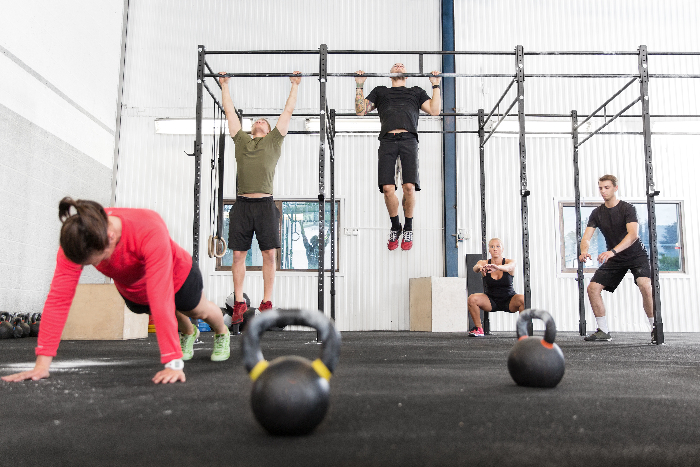Over the past few decades, there has been quite a buzz on whether high-intensity interval training results in greater health benefits as compared to other exercise types.
Improvements in cardiovascular function have been seen in people of various activity levels from Olympic athletes, to patients with cardiovascular disease.

As a result, there is an increasing amount of effort to incorporate HIIT exercises into exercise regimens.
Some professionals prefer solely HIIT exercises, while others simply add certain HIIT exercise workouts in addition to their normal exercise routine.
Property of rehaballey.com
So what are HIIT exercises? How do you perform these exercises? Are they beneficial? What does the research say about HIIT exercises? Can HIIT exercises be tailored to individual needs, and physical conditions?
In this blog, I will be answering these questions to hopefully give you a better understanding of what HIIT exercises are, as well as the potential health benefits.
What is HIIT Exercise?

High-Intensity Interval Training (HIIT) is a type of exercise routine that alternates between short bursts of high-intensity exercises followed by low-intensity exercises or short resting periods.
These exercise intervals are then repeated and performed for a specified period of time. HIIT exercises became popular in the 1950s when it was found to improve the performance of Olympic athletes.
Property of rehaballey.com
The idea behind HIIT exercises vs. the standard (moderate) continuous exercise is that a greater amount of high-intensity exercises are achieved during an exercise session which may result in significant improvements in aerobic and cardiovascular function.
Further studies suggest that HIIT exercises may improve cardiovascular function in healthy adults, children, and athletes, as well as patients with cardiovascular and chronic diseases.
Property of rehaballey.com
More studies, however, are needed to determine whether HIIT exercises produce a significant change in the overall quality-of-life as compared to other exercise types.
HIIT Exercise Prescription

The effectiveness of high-intensity interval training on various population groups found that overall HIIT exercises did improve cardiorespiratory fitness and aerobic capacity, particularly in patients with cardiovascular disease.
Patients with cardiovascular disease also reported less dyspnea (difficulty breathing), and symptoms of leg discomfort indicating possible peripheral muscle changes as well (LINK).
Property of rehaballey.com
A systematic review on the effects of HIIT exercises in children and adolescents (LINK) showed improvements in cardiovascular disease markers and supported more running-based sessions.
Lastly, evidence suggests that HIIT exercises can be a time-effective strategy for improving overall cardiovascular fitness with less amount of time needed, as compared to moderate-intensity continuous exercise (MICT).
However, the exact intensity, duration, and frequency of exercises in order to experience noticeable improvements in cardiorespiratory fitness have yet to be fully determined.
Property of rehaballey.com
As of now, there is little evidence of the exact prescription of exercises needed to produce these desired outcomes.
One study (LINK), however, suggests the exercise types as well as the prescription of exercises should be tailored to each individual’s needs and exercise tolerance.
The study also suggests that measurements such as percentage HRmax, percentage HR reserve, percentage VO2 Max, percentage VO2 reserve, and RPE were needed to determine each individual’s exercise-to-rest ratio.
Generally, you want the high-intensity exercise to be above 75% maximal oxygen consumption (VO2max), and the low-moderate recovery periods to be at 40%-50% (VO2max).
Property of rehaballey.com
As a result, the typical ratio is thought to be 1 minute of high-intensity exercise, followed by 1 minute of low-intensity exercise.
Therefore, HIIT exercises need to be intense enough and last long enough to improve cardiorespiratory function.
Otherwise, there will be no significant difference in cardiorespiratory fitness levels as compared to standard (moderate) continuous exercises.
Possible benefits of HIIT exercises compared to moderate intensity continuous exercises (MICT) include:
1. Increased cardiovascular fitness
2. Increased aerobic capacity
3. Higher intensity of exercise during a training session
4. Less time spent exercising
HIIT Exercise Types

There are numerous HIIT exercise types, however, they differ from person-to-person depending on overall fitness levels. One research article (LINK), gave examples of different exercises for sedentary individuals, as well as aerobically trained individuals which are listed in the table below:
| Population | High-Intensity | Low-Intensity | Number of Cycles |
| Sedentary | 30 seconds each: Push-ups, Squats, Tricep Dips, Butt Kicks, Side lunges, Jumping Jacks, Sit-ups | 15-second rest break between each exercise; 1-minute rest between each cycle | 3 |
| Aerobically Trained | 20 seconds each: squat jacks, push-ups with oblique knee (alternating), star jumps, burpees, thigh slaps, high knees, mountain climbers, jumping lunges | 20 seconds rest after every 2 exercises; 1-minute rest between each cycle. | 4 |
Note: A cycle is the completion of all the exercises listed with the low-intensity rest breaks in between.
Click HERE for a video of each of the exercises listed.
Based on evidence and experience as a physical therapist, I developed a HIIT exercise regimen for patients diagnosed with cardiovascular disease.
Property of rehaballey.com
The evidence (LINK) used to determine the following exercise regimen for cardiovascular patients performed HIIT exercises at 80%-90% VO2peak. These exercises are listed in the chart below.
ALLEY TIPS: Make sure to speak with a healthcare provider before starting any new exercise regimen.
Always adhere to any precautions ordered by your doctor when exercising. Monitor your vitals such as heart rate, blood pressure, and oxygen saturation while you are exercising.
Property of rehaballey.com
If you experience any intense pain, difficulty breathing, dizziness, light-headedness or any other symptoms suggesting extreme fatigue or overexertion, stop immediately.
Refer to the disclaimer page (LINK) for additional information.
| Population | High-Intensity | Low-Intensity | Cycles |
| Patient’s with cardiovascular disease | 30 seconds each: step-ups/step-downs (4-6” step), step-taps, miniature squats, marching (alternating), heel raises, hip abduction/adduction | 15 seconds rest between each exercise; 1-minute rest between each cycle | 4 |
Hopefully, this article sheds some light on the effectiveness of HIIT exercise and how it can improve cardiovascular function when compared to standard (moderate) intensity continuous exercise.
For additional information on Exercise, nutrition, and maintaining a healthy weight as you age, please refer to https://www.retireguide.com/retirement-life-leisure/healthy-aging/nutrition/losing-weight-after-60/
Whether you are performing HIIT exercises or continuous exercises both exercise types will result in substantial improvements in overall cardiovascular fitness, strength, and quality-of-life.
Property of rehaballey.com
The goal is to GET MOVING by performing functional activities and exercises on a regular basis to avoid the harmful effects of a sedentary lifestyle.
If you would like more ideas on simple activities you can do to stay active, please refer to my blog by clicking this (LINK). GOD BLESS YOUR ENDEAVORS!!
References
1. High-Intensity Interval Training (HIIT) for patients with chronic diseases (LINK)
2. High-Intensity Interval Training Interventions in Children and Adolescents: A Systematic Review (LINK)
3. Effects of High-Intensity Interval Training Compared to Moderate-Intensity Continuous Training on Maximal Oxygen Consumption and Blood Pressure in Healthy Men: A randomized Control Trial (LINK)
